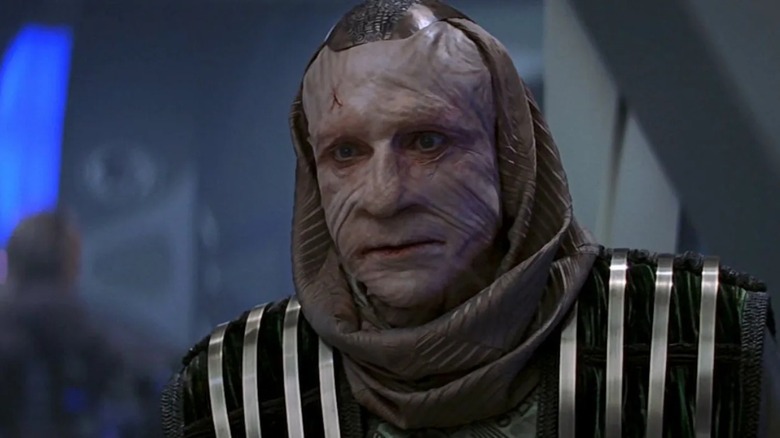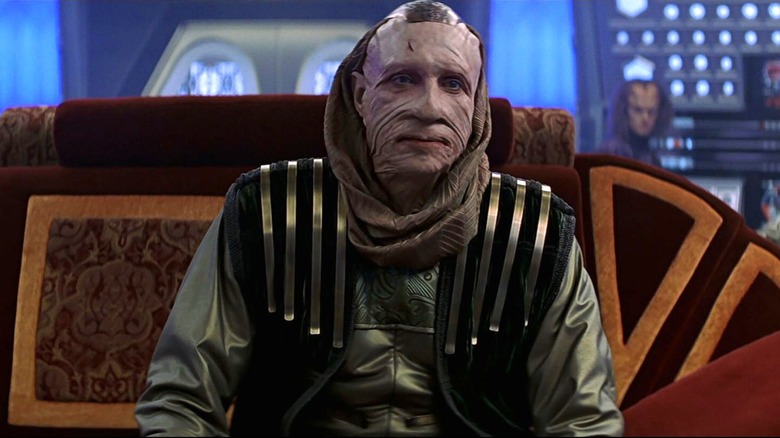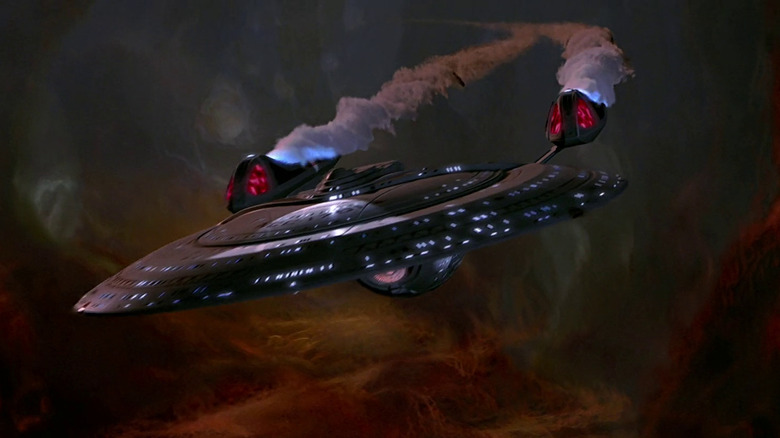Star Trek: Insurrection Was A Rare Example Of Studio Execs Improving The Series
Jonathan Frakes' 1998 film "Star Trek: Insurrection" was about a remote planet called Ba'ku, the home of a gentle colony of farmers who, thanks to a quirk of the planet's radioactive rings, can live healthily for centuries. A shady species called the Son'a have teamed up with Starfleet to harvest the radiation from the Ba'ku homeworld and forcibly relocate the citizens. Captain Picard (Patrick Stewart) feels that the forced relocation of the Ba'ku is morally wrong under the circumstances, and stages the titular insurrection.
The film climaxed with Picard and the Son'a captain Ru'afo (F. Murray Abraham) fighting one another for control of the radiation collector. Picard was in his 60s and Ru'afo's body and face had been ruined by many years of cosmetic surgery. While Picard and Ru'afo engaged in a fistfight, Commander Riker (Frakes) battled a Son'a ship using scooped-up explosive gases as a weapon. On the planet below, the rest of the Enterprise crew fought off flying isolinear drones that aimed to transport the Ba'ku off the surface.
"Insurrection" was a relatively lower-profile affair than the two "Star Trek: The Next Generation" movies that preceded it, so the action wasn't exactly high-octane, but one can see that the filmmakers wanted there to be a lot of incidents. In the oral history book "The Fifty-Year Mission: The Next 25 Years: From The Next Generation to J. J. Abrams" edited by Mark A. Altman and Edward Gross, Frakes recalled the mandate for more action actually came from studio execs. He felt that their decree was the correct choice. Otherwise, the film would have skipped straight to a beatific epilogue without much action confrontation.
The studio wanted more action
Frakes recalled the epilogue to "Insurrection" as being appropriate for the story, but that the initial script got to those final scenes too quickly. In the epilogue, Deanna Troi (Marina Sirtis) and Dr. Crusher (Gates McFadden) returned from a phaser battle on a mountainside, while the android Data (Brent Spiner) learned how to play in a haystack with a Ba'ku boy. The only action scene was going to be the scene of Picard and Ru'afo fighting on board the radiation collector, followed by a flirty conversation with a Ba'ku woman named Anij (Donna Murphy). Perhaps most shocking of all, there wasn't going to be a massive, climactic explosion. Frakes said:
"What was always there at the ending was the bit with Beverly and Deanna coming back down the hill, Patrick and Anij having their little walk, and Brent and the boy playing in the haystack. Prior to that it was just Murray and Patrick mano a mano, and the collector. But the collector didn't blow up, Riker didn't come and save the day with the Enterprise, Worf's ship was not retaken by the bad guys. To the studio's credit, they said, 'We'd like to see more action here at the end because the audience expects more.'"
Frakes admitted in a behind-the-scenes interview included on the "Insurrection" DVD that he felt "Star Trek" should be more action-oriented. As the director of "Insurrection," he was likely pleased to abide by their mandate. After all, this was a feature film and not a mere episode of "Star Trek: The Next Generation," and feature films are better suited to simplified action climaxes (even if "Star Trek" at large isn't particularly well-suited to action in general; not all us Trekkies agree with Frakes' sentiments).
Everyone wants to see the Enterprise save the day
Watching "Insurrection," one can see the ways action was inserted. There are a lot of hastily written action one-liners like "We're getting too old for this" and "Time's up." The action mandate also dictated that a radiation collector — a piece of scientific hardware — should be equipped with a self-destruct mechanism. It's illogical that the collector should have a self-destruct option, but the studio wanted a big explosion, and Frakes was ready to provide a big explosion. He and the studio agreed on a three-prong action climax. Frakes recalled:
"[I]nstead of just having two guys fight it out to the end, we were able to weave three stories, with the collector blowing up, the Enterprise going back — everyone wants to see the Enterprise save the day — and the bad guy ship is involved. We got Worf in one ship, Riker in one ship, and Picard about to give up his life. So the stakes went up a lot and it really improved. There were definitely a lot of ups and downs during the making of this film."
Ultimately, "Insurrection" wasn't terribly well-received, getting only warm reviews and only modest box office receipts. Frakes did, however, do his job of incorporating more action into the film's climax. The four "Next Generation" movies tended to eschew the cerebral rigors of the TV series, leaning more heavily into fights and weapons. That said, "Insurrection" was the one film of the four (which also included "Star Trek: Generations," "Star Trek: First Contact," and "Star Trek: Nemesis") that closely mirrored the original show's tone. I just wish Ru'afo had lived.


